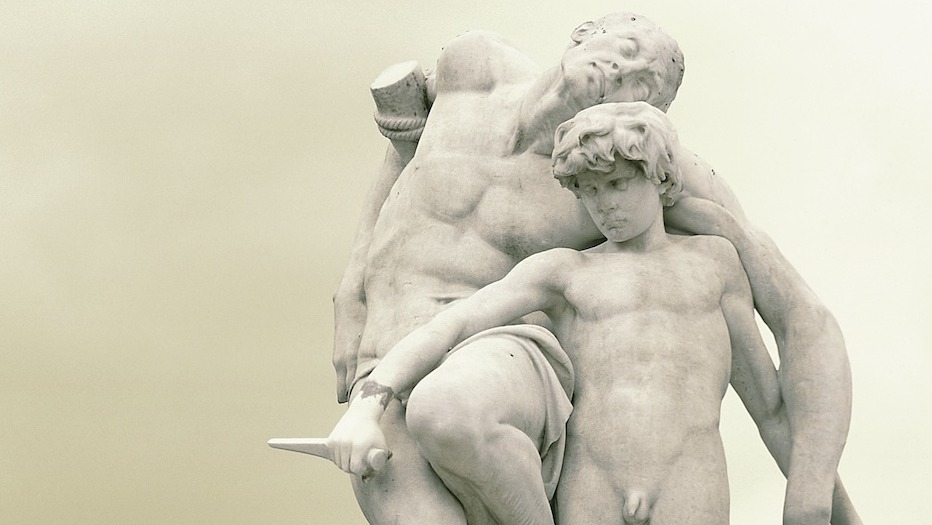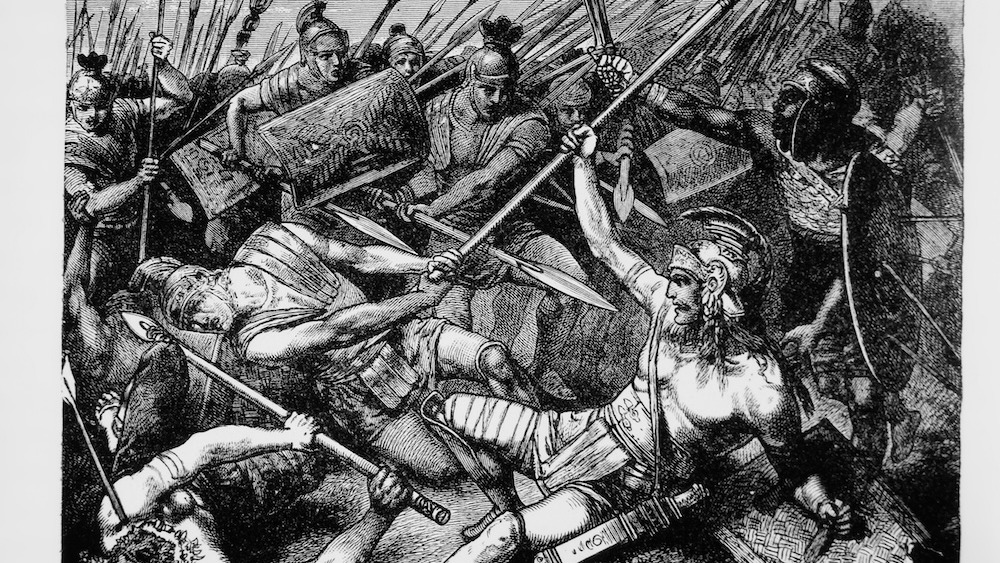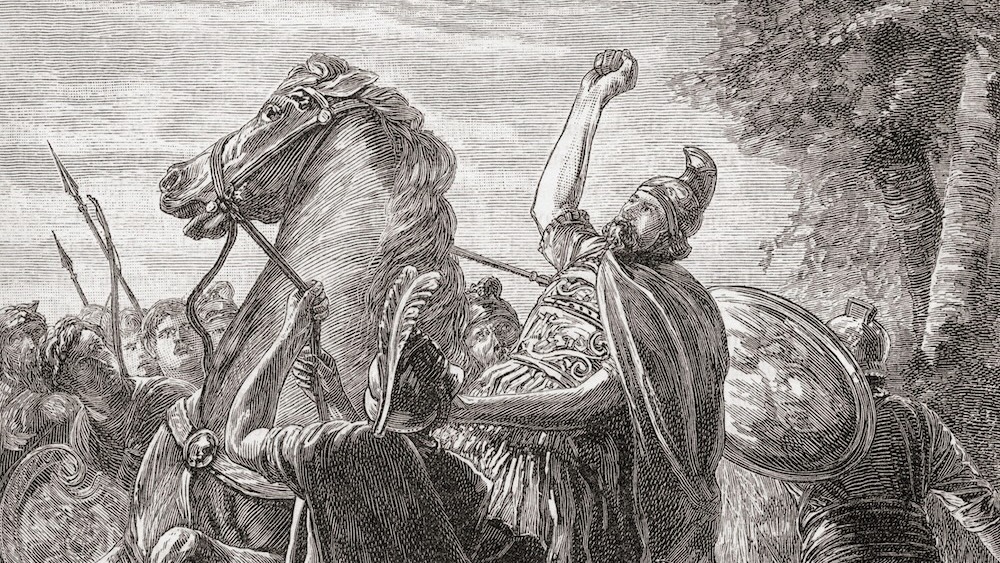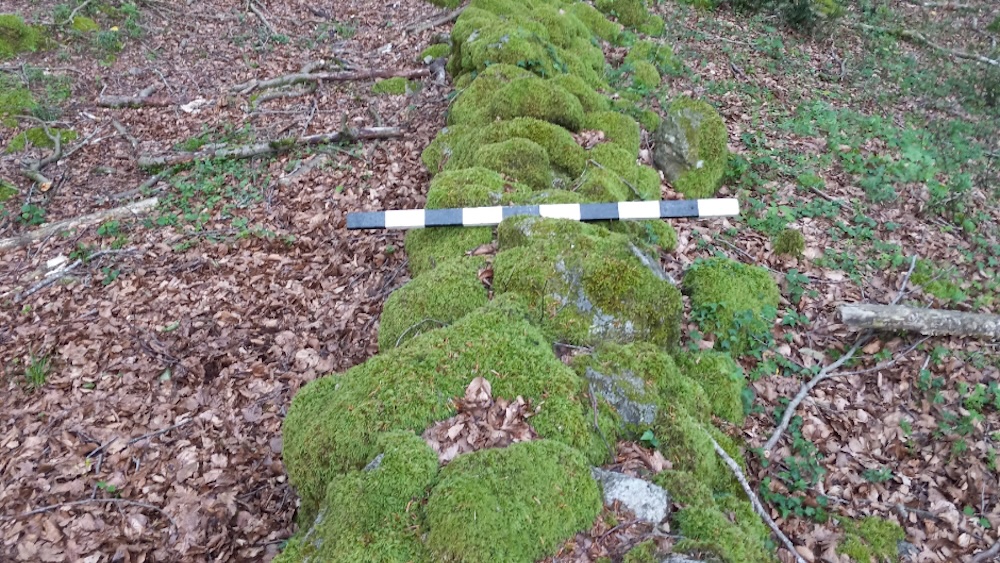Spartacus, the gladiator who led a slave revolt against the Romans
The Thracian gladiator Spartacus, a popular character in movies and television, outsmarted the Romans until his demise in the first century B.C.

Spartacus was a Thracian gladiator who led a slave revolt with an army numbering in the tens of thousands. He defeated Roman forces over half a dozen times, marching his people up and down the Italian peninsula until he was killed in battle in April 71 B.C.
A favorite character in popular fiction, he was not crucified, and there was no "I’m Spartacus!" moment as seen in the famous 1960 Stanley Kubrick film. Also, while Spartacus was a real person who has inspired revolutionaries and filmmakers, scholars do not have an abundant amount of information about him. Accounts from only about a dozen ancient writers survive to this day, and none of the surviving reports was written by Spartacus or one of his supporters.
This is Spartacus
According to the surviving sources, Spartacus was from Thrace, an area in southeast Europe that the Romans were often trying to subjugate during the first century B.C. He appears to have served in a Roman auxiliary unit for a time, deserted and became either a bandit or insurgent against the Romans. At some point he was captured, brought to Rome and sold as a slave to a man referred to at times as "Vatia." This man owned a gladiator school in Capua, about 120 miles (193 kilometers) southeast of Rome. While at the school, Spartacus helped organize a breakout that led to more than 70 gladiators escaping armed with knives, cleavers and other makeshift weapons they got from the kitchen.
One of the people Spartacus escaped with was his wife, a Thracian woman whose name is lost to history. The writer Plutarch, who lived in the second century A.D., wrote that she "was a prophetess who was possessed by ecstatic frenzies that were part of the worship of the god Dionysus." After Spartacus woke up with a snake coiled around his head "she declared that this was the sign of a tremendous and fearsome power that would bring him to an unfortunate end" (translation by Brent Shaw, from the book "Spartacus and the Slave Wars: Brief History with Documents," Bedford/St.Martins, 2001).

First fight
Spartacus and his small band of escapees acquired gladiator weapons from a passing cart and made their way to Mount Vesuvius. This was more than a century before it erupted and, in Spartacus' time, the mountain was actually covered with vines and had fertile farmland nearby.
On their way, Spartacus and his co-leaders, Crixus and Oenomaus, raided for supplies and recruited slaves in the countryside. Rome did not respond to Spartacus' growing force seriously. At the time of his breakout, the Republic's military was fighting in Spain, southeast Europe and Crete. Furthermore, a group of escaped slaves were not seen as posing a serious challenge to Roman soldiers.
The Romans despatched a praetor named Gaius Claudius Glaber to form an army to crush the slaves. This man, and another person named Publius Valerius, whom they despatched later, "did not command the regular citizen army of legions, but rather whatever forces they could hastily conscript on the spot," wrote Appian, a writer who also lived in the second century A.D. (translation by Brent Shaw).
Glaber's ad-hoc army didn’t even try to attack Spartacus. Instead, they blocked off the main route up Vesuvius, pitched camp and tried to starve him out. Spartacus took the initiative, having his newly liberated slaves build rope out of wild vines so they could move down the mountainside to a spot the Roman had neglected to defend. The Romans, still in camp, never saw them coming. The "slaves were able to surround them and to shock the Romans with a surprise attack. When the Romans fled, the slaves seized their camp," Plutarch wrote. This success resulted in new recruits flocking to the force of Spartacus. "At this point, many of the herdsmen and shepherds from the surrounding regions — hard-bodied and swift-footed men — came to join the slaves."
The growth of Spartacus’s force was aided by other factors. Throughout his rebellion, his army spent much of its time in rural areas and small towns, places that were poorly defended but had an abundance of slaves. Additionally, according to ancient sources, Spartacus insisted on equally dividing the spoils, something that made recruitment all the more easier.
In time, he even succeeded in getting non-slaves to join his rebellion. "They were able to build such a formidable force in part because many freedmen and other free commoners joined their ranks along with thousands of fugitive slaves," writes historian Michael Parenti in an essay published in the book "Spartacus: Film and History" (Blackwell, 2006).
Serious opposition
Spartacus continued to ambush and defeat Roman units while freeing slaves in the countryside and gathering supplies. Back in Rome, the senate grew impatient and sent a large army led by the consuls Lucius Gellius Publicola and Gnaeus Cornelius Lentulus Clodianus. Each man may have commanded 10,000 troops.
By the spring of 72 B.C., Spartacus may have had 40,000 troops, some of which stayed in south Italy with his co-leader Crixus while the remainder advanced toward the Alps under the command of Spartacus.
This did not work out well for the rebels. The Roman force under Gellius caught up with Crixus, killing the leader along with many of his rebels. Gellius then proceeded to advance on Spartacus from the south while Lentulus, who was apparently ahead of Spartacus, drove in from the north. Spartacus was trapped between two armies likely equipped with better arms and armor then he had.
But one thing neither commander appears to have counted on was that Spartacus had built up a sizable cavalry force in the preceding months. Thracians were known to be good horseman, able to tame even wild horses. "Spartacus suddenly rushed at them and engaged them in battle. He defeated Lentulus' legates and captured all of their supplies," Plutarch writes. Gellius was then either defeated by Spartacus or forced to retreat. Spartacus had not only escaped the trap but had mauled the Roman army, allowing his troops to march to the Alps.
An Alpine mystery
After defeating another Roman force, this one led by a Roman governor named Gaius Cassius Longinus, Spartacus' force was now free to climb the Alps and go to Gaul, Thrace or other areas not controlled by Rome.
However, for reasons lost to history, Spartacus chose not to do this, instead turning his force around and heading back into Italy. Why he did this is a mystery.
"Many theories have been proposed, but the best explanation was already hinted at in the ancient sources. Spartacus’s own men probably vetoed him," writes Barry Strauss, a classics professor at Cornell University, in his book "The Spartacus War" (Simon & Schuster, 2009). "In the past, they had never wanted to leave Italy; now success might have gone to their heads and aroused visions of Rome in flames."
He notes that other factors may also have been involved. Spartacus may have received news of Roman advances in Thrace that made him doubt that he and the other Thracians in his army could return home safely.
"The last straw might simply have been the sight of the Alps," Strauss wrote. "As anyone who has ever looked up from the plain toward the rock wall of the Italian Alps knows, the mountains are overpowering."
Whatever the reasons were Spartacus led his army back south, through Italy, overcoming resistance along the way, until they arrived at the Strait of Messina, in hopes that they could cross over to Sicily, an island of agriculture and slaves waiting to be liberated.
Betrayed by pirates
While the Strait of Messina is small, being only 2 miles (3.2 km) wide at some points, Spartacus had several problems crossing it. He had reached the strait in the winter of 72-71 B.C., a time when the weather was colder. Additionally the Roman governor of Sicily, Gaius Verres, had fortified some of the best landing spots.
Spartacus needed two things, good boats and good sailors, to be able to land an advance party of his troops across the strait. He turned to a group of "Cilician pirates" (as Plutarch called them) who frequented the area and, who Strauss notes, were equipped with speedy boats and navigational knowledge, things Spartacus needed to make the crossing successfully.
The pirates, however, had other plans. "Although the Cilicians made an agreement with Spartacus and accepted his gifts, they deceived him and sailed away," wrote Plutarch. Whether the pirates had been bribed by the Romans, or just didn’t want to be involved, is not known.
Undeterred Spartacus ordered his troops to assemble boats of their own and, while they succeeded in building a number of them, their attempt to cross the strait failed, leaving his troops stuck on the Italian mainland. This left Spartacus with no choice but to take his force north to face a Roman leader more ruthless than any he had encountered before.

Crassus
By the time Spartacus had reached the straits a new leader named Marcus Licinius Crassus had taken command of the Roman forces. Strauss notes that he was a wealthy individual, able to raise a large army and pay them, at least in part, out of his own pocket.
In his business dealings Plutarch said that he had a scheme where "he bought up the burning properties and the buildings in the neighborhood of those alight, as the owners would surrender them for a small sum of money out of fear and uncertainty." (Translation from Roman Social History: A Sourcebook, Routledge, 2007).
In his military life he was even more ruthless. Among his forces were the remnants of legions belonging to Gellius and Lentulus that had been previously defeated by Spartacus. As a consequence "Crassus selected every tenth man from the consular legions by lot and had him executed," wrote Appian. He also revived a practice called "decimation" where units that ran away from the enemy would draw lots and have a random number of soldiers killed by being clubbed or stoned to death.
Needless to say discipline tightened under Crassus. Still, knowing that many of Rome's best soldiers were outside Italy, he proceeded carefully when moving against Spartacus. Rather than try and openly battle Spartacus in southern Italy he built a system of fortifications centred on the Melia Ridge in an effort to trap Spartacus and starve his troops.
Spartacus responded to the situation by offering Crassus a peace treaty which Crassus swiftly rejected. Perhaps seeing his own soldiers beginning to waver Spartacus stiffened their resolve by crucifying a Roman soldier where all could see. It served "as a visual demonstration to his own men of what would happen to them if they did not win," wrote Appian. Spartacus eventually managed to break through Crassus’s trap by filling in one his trenches (allegedly with human bodies) and using his cavalry to punch through.
While Spartacus escaped Crassus' trap he faced serious consequences. Ancient writers say that he lost thousands of soldiers in the break out. Furthermore a split emerged in the rebel camp. A dissident group led by Castus and Gannicus, which included many Celtic and German troops, broke away from Spartacus and set off on their own. Additionally Crassus' force was still largely intact while another force, led by Marcus Terentius Varro Lucullus, was about to land at Brundisium and a third force, led by Pompey, was on its way to Italy from Spain.
Spartacus' force was now divided and increasingly surrounded and the stage was set for the final battle.

The stone wall
In 2024, archaeologists excavated the remnants of a stone wall that stretches roughly 1.7 miles (2.7 km) long in the Dossone della Melia forest in southwestern Italy. Roman forces had built the wall to trap Spartacus and his forces during the Third Servile War (also known as the Gladiator War), which happened between 73 and 71 B.C. In addition to the wall, researchers unearthed a range of weapons, including sword handles, curved blades, javelin points and a spearhead from the epic revolt.
The end of Spartacus
In the spring of 71 B.C., things fell apart for Spartacus. Castus and Gannicus were defeated by Crassus, likely sometime before April, at the Battle of Cantenna.
Spartacus was now isolated further. After the battle at Cantenna he received news that Lucullus' force had landed at Brundisium, crushing the hopes the rebels had for getting out of Italy by using that port.
What happened next is hard to explain. Spartacus could have tried for another port, or another part of Italy. His force was not completely trapped and he likely had at least 30,000 troops able to fight.
But, for reasons we do not know, he decided to turn around and attack Crassus. Whether Spartacus really wanted this, or whether his men decided this for him, is not known.
The final battle took place in April 71 BC. Strauss says that we cannot be sure where it was fought but it was likely somewhere in the Upper Silarus Valley. Spartacus' strategy appears to have been two-fold, use his cavalry to attack Crassus' archers and missile throwers while Spartacus would lead his infantry in an attempt to kill Crassus himself, hoping to break up his army.
Crassus built trenches to block Spartacus' cavalry prompting a wild melee when Spartacus' men jumped in and tried to stop their construction. Eventually Spartacus lined up his men for battle and Crassus his.
Plutarch wrote that, just before the battle, Spartacus got off his horse, killed the beast, and told his men that "if he won the battle, he would have many fine horses that belonged to the enemy, but if he lost he would have no need of a horse." The battle went poorly. Spartacus' cavalry was apparently unable to reach Crassus' missile throwers and archers. Undeterred Spartacus, at the head of his troops, and on foot, led a charge aimed at Crassus himself.
Spartacus is said to have hacked down two centurions in this final attempt, however it was in vain. There are varying accounts about Spartacus' death but they all end with him being surrounded and killed. With his death his army fell apart and Crassus and the other Roman forces hunted down the remaining rebels.
Where is Spartacus buried?
The body of Spartacus was apparently never identified. Strauss points out that he had killed his horse before the battle and probably did not embellish his armor. "Spartacus’s final struggle might have left only the badly disfigured body of a soldier dressed in ordinary armor." He was likely buried in a mass grave with the rest of his troops. Even if archaeologists do find it someday they likely would be unable to distinguish the famous commander from that of his troops.
While Spartacus' uprising was ultimately crushed his memory lives on, more so than the Romans who fought against, or otherwise opposed, him. "Who, today, remembers Crassus? Pompey? Even Cicero is not so well remembered," writes Strauss. On the other hand "everyone has heard of Spartacus."
Editor's note: This piece was originally published on Sept. 17, 2013 and updated on July 11, 2024 to include information about a recently discovered stone wall built to trap Spartacus and his forces.
Sign up for the Live Science daily newsletter now
Get the world’s most fascinating discoveries delivered straight to your inbox.

Owen Jarus is a regular contributor to Live Science who writes about archaeology and humans' past. He has also written for The Independent (UK), The Canadian Press (CP) and The Associated Press (AP), among others. Owen has a bachelor of arts degree from the University of Toronto and a journalism degree from Ryerson University.










